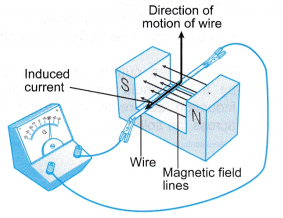The setup below will help us do simple experiments to determine how we can use Fleming’s Right-hand rule to determine the relation between direction of magnetic field, movement of conductor in the magnetic field and the direction of the induced current.

consider the setup below

To investigate direction of current on the straight conductor AB, one may follow the following steps:
- Move the conductor to cut the magnetic fields vertically upwards and note the direction of the magnetic field.
- Move the conductor to cut the magnetic fields vertically downwards wards and note the direction of the magnetic field.
- Hold the wire stationary in the magnetic field and note the deflection
Observations
When we move wire upwards, the deflection on the galvanometer goes right. This shows that the current is flowing from A to B. To represent that on a paper, imagine that the induced current is moving into the page away from the eye as in the following illustration.

When we move the wire is downwards, deflections goes left showing that the current is moving from A to B . We represent Current flow on a paper with an arrow moving out of the page. In the diagram below, the current is moving towards the eye as shown.

Fleming’s Right-hand rule
We can determine direction of an induced current in a straight conductor using Fleming’s right-hand rule which states that:
If you hold the thumb and the first two fingers of the right hand mutually at right angles with the first finger pointing in the direction of the magnetic field and the thumb pointing in the direction of motion, then the second finger points in the direction of the induced current.
Figure below shows how we hold the first three fingers of our right hand to determine direction of the induced current use of Fleming’s rule.

Fleming’s right hand rule is also known as the dynamo rule and it agrees with the Lenz’s law.
Consider a horizontal magnet held as shown in figure below:

The direction of the magnetic field is downward.
We represent downward direction of the above magnetic field with section of an arrow tail to show that the magnetic field is going down into the paper.
Suppose we have a conductor held horizontally between the two poles, the conductor will slide away or towards the magnet if it has some current flowing.
The figure below shows current through a certain conductor XY inside a magnetic field moving into the paper and the likely motion for such a setup.

According to Fleming’s right-hand rule rule which is consistent with the Lenz’s law, the current must flow from X to Y in order to produce an electromotive force that is to push the rod XY to the right.
Related topics
- The Lenz’s law
- Magnitude of induced EMF
- Magnetic Field patterns For a straight conductor
- Hans Oersted
- Calculus Integration
- Induced Electromotive force
- Magnetic effect to an electric current
References
- Secondary Physics Student’s Book Four. 3rd ed., Kenya Literature Bureau, 2012.
- Tom D., and Heather K. Cambridge IGCSE Physics. 3rd ed., Hodder Education, 2018.


Leave a Reply